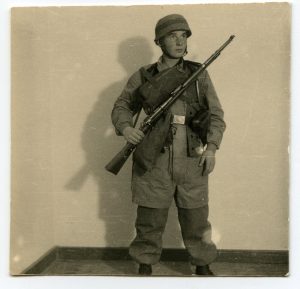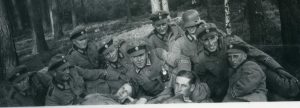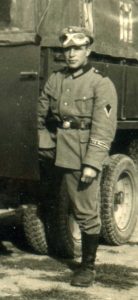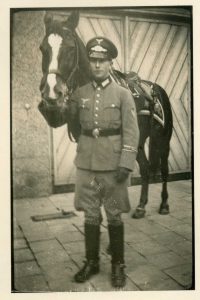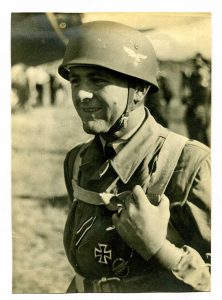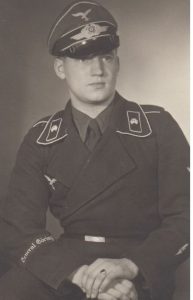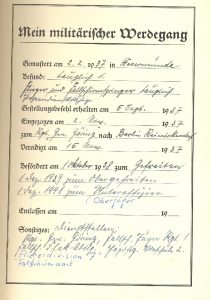Well Friends,
with the cuff title of Fallschirmjäger Regiment 1 there is special connection. In 1995 I was with my ship „Zerstörer Rommel“ (a german destroyer DDG 103 B) on basic operational sea training in England. During a visit in the city of Plymouth I found an antique store which also sold some medals and badges. There was a Fallschirmjäger Regiment 1 cuff title and I bought it for small money (think it was about 150,- DM which are now 75,- Euro)
Happy to bring it back to Germany and I put it in my collection.
Years later I found out it was a fake on…..lesson learned 😉
All the regiment cuff titles you see here are originals !
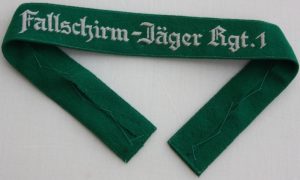
These cuff titles were manufactured from dark green badge-cloth, were 3.2 cm wide and were executed in “Frakturschrift” as follows:
– For Officers the cuff title was hand embroidered in aluminum thread and featured the addition of an approximately 3 mm wide aluminum braid (Soutache) edging.
– For NCOs, the cuff title had machine embroidery made of matt gray or whitish-gray cotton and featured an approximately 3 mm wide cotton braid (Soutache) edging .
– Although similar in material and color the version for enlisted men lacked the braid edging.
Very important to know is that the cuff titles of FallschirmJäger-Regiment 1 are the only ones were also cuff titles for enlisted men can be found which are HAND embroidered letters !!!!

Method of Wear:
The cuff title was worn on the Tuchrock just above the turned back cuff of the right sleeve. When worn by a soldier holding an appointment to the position of “Spieß”, it was attached just above the sleeve rings indicating this status. Officers also wore the cuff title on the Fliegerbluse and the white Summer Tunic. It`s evidenced by numerous photographs however, that the wearing of this cuff title was probably complied with less and less over the course of the war.
Note: A formal date of introduction was not discovered for the cuff titles with the names Regt. 4 and Regt.5 . One explanation for this would probably be that when examples of this cuff title are encountered they are mostly of makeshift appearance, fabricated by the troops themselves. In the relevant cuff titles, the original numbers have been removed and replaced by a rather coarsely embroidered 4 or 5.
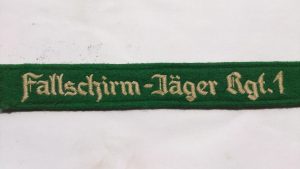
History Fallschirmjäger- Regiment 1
The formation of Fallschirmjäger-Regiment 1 began on April 1st, 1938, based around IV. (Fallschirm) Bataillon from „Regiment General Göring“. The battalion, consisting of five companies, was the main battalion of the “Fallschirmtruppe” and initially formed 1st battalion of the regiment in Stendal, which was subordinated to 7th Flieger Division under General Student, in the context of plans for use in the Sudetenland.
On September 1st, 1939 the former “Heeres-Fallschirm-Infanterie-Bataillon (Braunschweig)” joined the Luftwaffe as 2nd / 1 , and the “Luftlande-Bataillon General Göring“ (moved from Berlin to Gardelegen ) joined the Regiment as 3rd / 1.
In March, the three battalions were intended to be used as part of the 7th Flieger Division in occupying the rest of Czechoslovakia, but due to bad weather they did not take part.
After formation of a “Regimentsstab” in June 1939, Bruno Bräuer took over as the first commander of the regiment.
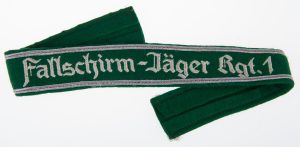
During the Polish campaign some missions were planned for 7th Flieger Division , however they were initially not used. Subsequently during the campaign however, parts of the regiment were used in ground combat at Radom and Pulawy .
In early April 1940, the 1st / 1 was prepared for use in Norway, where it went into action from April 9th, 1940. The German paratroopers took the airfields at Oslo-Fornebu and Stavanger-Sola and secured the Storstromme Bridge. Also the 1st company fought in the Dombas area.
For use in Belgium in 1940, parts of the regiment were detached to “Sturm-Abteilung Koch”. In addition, 1st and 2nd battalion received the order to capture the important bridges at Moerdijk and Dordrecht . The 3rd / 1 was to occupy the airfield at Waalhaven, land a platoon on the outskirts of suburban Rotterdam-Feyenoord and capture the Rotterdam bridges. 3rd battalion achieved its goals, and the 1st and 2nd / 1 also fulfilled their duties, albeit with heavy losses. The days which followed were taken up in determined fighting to hold the positions which had been captured. The regiment contributed significantly and at the foreground of the successes of the paratroops in the western campaign.
At the end of May 1940, the regiment was moved to Norway and supported the struggles in the Narvik area with General Dietl.

After the conquest of the Balkans came the task of occupying the island of Crete, as part of operation „Merkur“. The regiment was employed in the 2nd wave, as part of “Gruppe Ost”, to occupy the city and airport of Heraklion. This task, after suffering heavy losses on the first two days of the operation (2nd / 1 lost about 400 men), could not be achieved and so the regiment was given the task of holding the enemy and preventing the use of the airfield. On May 29th, 1941 the airfield and the town of Heraklion were occupied after being evacuated by British troops. With this, the eastern part of the island also capitulated and 200 Fallschirmäger prisoners could be freed. Among the 3,094 fallen paratroopers were numerous members of Fallschirmjäger-Regiment 1.
After the end of the fighting, the regiment was the first paratrooper unit to be moved back home and in August they arrived at the “Truppenübungsplatz” Bergen-Hohne. The 2nd / 1 was temporarily renamed as the “Fallschirm-Lehr-Bataillon” and the losses in Crete were more or less made up.
On September 24th, 1941 came the order to insert a Fallschirmjäger-Regiment into the area south of

Lake Ladoga on the northern section of the Eastern Front. The choice fell on Fallschirmjäger-Regiment 1, to take the place of the missing 2nd / 1, 2nd / Storm Regiment. With this action, the process began of removing the paratroops from their own specialist role and to use them as regular ground combat troops. Subsequently, the remaining parts of the 7th Flieger Division were also used in this manner and thereby suffered severe losses because of often used being used in a fragmented manner. Having arrived at the limits of their combat effectiveness in late November a return home was warranted but the increasingly deteriorating situation on the eastern front prevented this. Only in May 1942 was the refresh of almost all units carried out in Normandy, where the Regiment was given a new 2nd battalion. In mid-October 7th Flieger Division moved into the area of “Heeresgruppe Mitte”. In January 1943, the 3rd / 1 was moved into the Welikije Luki area, there to relieve an encircled “Kampfgruppe” at temperatures of -43 ° C. After a few quiet days bivouacked there, there was a major enemy attack, which the battalion withstood and was returned to the 7th Flieger Division on January 16th 1943. A short time later came an alarm involving the whole regiment near Orel, where it was replaced in March 1943 after the position was stabilized.
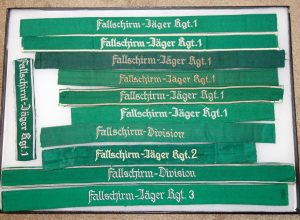
Between February and May 1943, 7th Flieger Division was renamed as 1 Fallschirmjäger-Division, into which Fallschirmjäger-Regiment 1 was also absorbed. At the end of April the Division was assembled in Normandy and was then relocated in May / June to southern France. The Division was located in the Rhone Valley. In March 1944, 3rd / 1. had been removed and used in the formation of the 3. Fallschirmjäger-Division. It was subsequently reformed.
In July 1943 came the action in Sicily, where a move of Fallschirmjäger-Regiment 1 by rail was carried out. During this movement, the regiment was stopped and moved into the area Eboli to be used in case of a possible Italian withdraw from its alliance with Germany.
In September the Regiment came under the control of its division at the Allied bridgehead at Salerno and then at Cassino. The regiment earned a legendary reputation there, but was eventually forced to retreat. In June in the area around Rimini, the regiment was one of the last German units to cross the Po. Withdrawing to the Alps, the Regiment rejoined the rest of the Division on May 2nd, 1945.
Hope that the Fallschirmjäger-Regiment 1 information was good for your hobby!
Subscribe for more and get an email every time a new article goes online !
Help us on Facebook to get to collectors all over the world !!
Best
Sascha
Copyright 2018 : Alle Rechte bei dem Verfasser Sascha Ulderup / All rights with the author Sascha Ulderup
